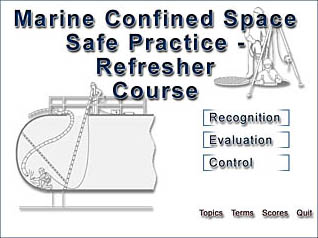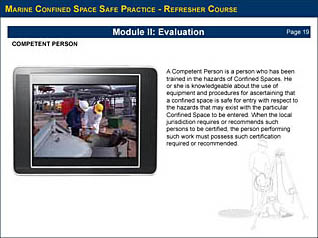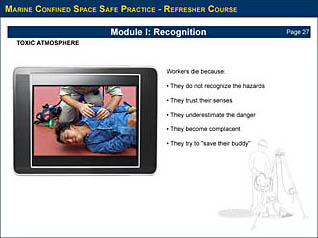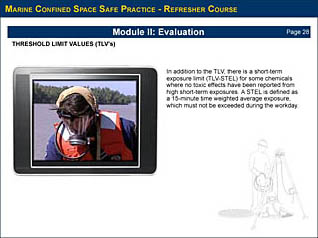Confined Space: Marine Confined Space

- Product ID
- moximcsp
- Training Time ?
- 129 to 258 minutes
- Language(s)
- English
- Video Format
- Standard Definition
- Required Plugins
- MasteryNet Player
- Lesson Interactions
- 5
- Quiz Questions
- 21



This refresher training prepares anyone working in or around confined spaces to recognize, evaluate, and control the environment of a confined space. Presented with graphics, text, and complete narration, the training defines a confined space and explains how to recognize and understand atmospheric and physical hazards within confined spaces.
The user learns about qualitative and quantitative methods of measurements used in evaluate confined spaces, and how that relates to safe entry. Finally, learner are taught the precautions necessary to maintain safe entry, work, and exit conditions within a Maritime confined space.
![]() This course is in the Advantage™ format, to read about Advantage™ features click here.
This course is in the Advantage™ format, to read about Advantage™ features click here.

- Rich multimedia presentation with interactions and quiz
- Print certificate and wallet card
- You have 30 days to complete the course
Training for anyone working in or around confined spaces.
-
Recognition
- Introduction
- Access
- Oxygen-deficient
- Flammable atmosphere
- Toxic atmosphere
- General physical hazards
-
Evaluation
- Testing the atmosphere
- Ventilate and retest if necessary
- Role of the certified marine chemist
- Competent person
- Threshold limit values (TLV's)
- Toxins
-
Control
- Ventilation
- Isolation
- Rescue
- Respiratory protection
-
Recognize a confined space.
- List characteristics of a confined space.
- Define entry.
- Recognize the hazards in confined spaces.
- Agree to never rely on sense of smell to detect chemical vapors.
- State the normal amount of oxygen in air.
- Explain why oxygen deficiency's considered greatest atmospheric hazard.
-
Evaluate confined spaces for safe entry.
- Identify persons authorized to perform initial testing.
- Name persons authorized to perform subsequent maintenance testing.
- List the areas necessary to test for gases in a confined space.
- Select the action to take when testing reveals oxygen deficiency, or toxic gases or vapors within a confined space.
- Recognize the safety range of the Lower Explosive Limit.
- List the effects of chemical toxicity.
- Define the Threshold Limit Value.
- Appraise conditions within confined spaces.
- Identify hazardous gases within a confined space.
-
Work safely within a confined space.
- Explain why ventilation is important.
- Choose the process dangerous to be completed within a confined space.
- Recognize when standby personnel can safely enter a confined space.
- Agree that rescuers must be trained and follow established emergency procedures.
- Identify respiratory protection as the second line of defense against dangerous atmospheres.
- Agree that facial hair is not allowed when wearing a respirator.
- Explain why chemical filters are the least effective type of respira
© Mastery Technologies, Inc.



